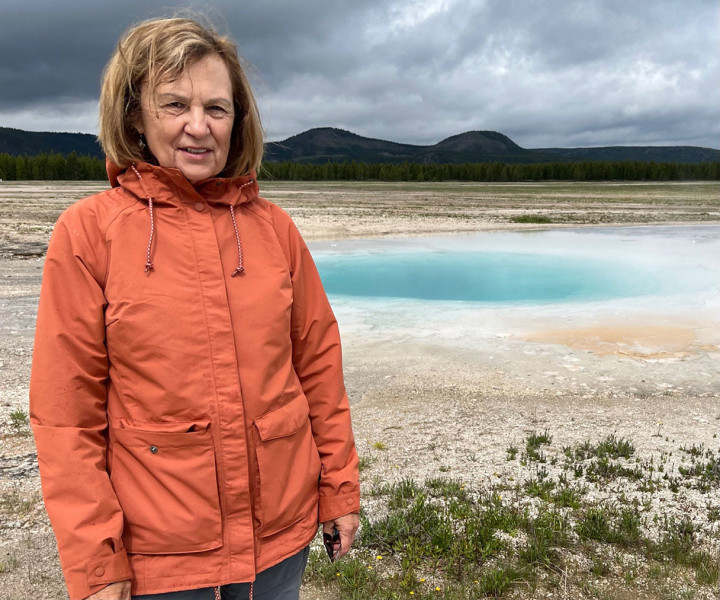News — LOS ANGELES (May 5, 2025) -- Two summers ago, Terry Carroll’s lower back pain and sciatica—pain radiating down the leg—had become so severe that his walk had become a shuffle and merely getting out of his car felt debilitating.
“I probably needed a walker,” said Carroll, 68. “It was that bad.”
An orthopedic surgeon near his home in Northern California recommended a spinal fusion, an invasive surgery in which vertebrae are joined together to stabilize the spine, reducing pain. Recovery can take many months.
“It seemed like a harsh solution,” Carroll said. “But if that was what I needed to get out of pain, I figured it was what I had to do.”
When a physician friend encouraged him to get another opinion, Carroll turned to the program. It gives patients outside Los Angeles a convenient way to access—at home, from their computer—customized treatment options by the medical center’s experts.
Carroll was quickly connected with spine surgeon , assistant professor of Orthopaedics and director of at Cedars-Sinai. Kim evaluated the imaging studies from Carroll’s original surgeon and then made a video call to Carroll to share his opinion about his treatment options.
“Terry had a foraminal disc herniation—a ruptured disc in the foramen, an area where nerve roots exit the spine and go to different parts of the leg,” Kim said. “That was causing weakness and pain.”
Kim recommended an extraforaminal microdiscectomy—a minimally invasive procedure with a faster recovery time than that of spinal fusion. Instead of fusing vertebrae, he would remove the part of the disc pressing on the nerve root.
Carroll was able to pursue the second option, thanks to Kim's expertise.
“I routinely perform extraforaminal microdiscectomies at Cedars-Sinai, but they are not commonly performed everywhere,” Kim said. “Some surgeons are not as familiar or comfortable with the procedure.”
Carroll told his surgeon in Northern California he was going to Cedars-Sinai for treatment.
“He completely understood, and it was all very professional,” Carroll said.
The surgery was on a Friday, and Carroll walked out of Cedars-Sinai the next day.
“My recovery was almost immediate,” he said. “I had worried that the treatment wouldn’t be a silver bullet, but it was. My goal was to get my life back, and in the hands of a skilled surgeon, I did.”
Sticking With the Original Opinion
Some patients who seek a virtual second opinion at Cedars-Sinai decide to follow their original physician’s treatment plan.
For Barbara Pitcher, of Idaho, spinal stenosis—a narrowing of the spinal canal that puts pressure on the spinal cord—as well as scoliosis—an abnormal spine curvature—were causing hip and thigh pain.
“I’m a very active person and wanted to live my life,” she said.
Pitcher, a retired nurse, saw her local spine surgeon, who recommended a two-level fusion and discectomy. Before proceeding, Pitcher went online and found Cedars-Sinai’s Virtual Second Opinion program. She was encouraged to learn the medical center had a spinal stenosis specialist.
“This is exactly what I need,” Pitcher thought.
Right away, Pitcher was connected with Kim for an online consultation and a review of her MRI. Kim told Pitcher he agreed with the original surgeon’s treatment approach.
“I gave Barbara two options to consider,” Kim said, “but because she had scoliosis and spinal stenosis, I told her I felt fusion surgery was likely the best option for her.”
Pitcher said Kim relieved her anxiety about what to do.
“He was patient, answered every question and put my mind at ease,” she said. “Connecting with a specialist at a larger medical center that does many spine surgeries was great.”
Pitcher decided to have surgery in Idaho, for convenience. Her recovery has been smooth, and she is getting back to the outdoor activities she loves.
“A virtual second opinion from an expert fills the need of people like me who live in a rural area and would like a bit more direction,” Pitcher said.
Building Trust, Near and Far
Through Virtual Second Opinion, Kim often meets patients like Carroll and Pitcher who live in rural areas and may not have access to a wide range of specialists.
“I feel like I’m making a big difference for these patients,” Kim said. “Sometimes they just need reassurance that the treatment they are considering in their local area is right for them, and I’m happy to provide that.
“Another advantage is the video portion of the Cedars-Sinai second opinion. It helps patients and physicians immediately start to build a rapport in that first virtual meeting. Patients feel comfortable saying, ‘I trust this person to take care of me.’”
Read more on the Cedars-Sinai Blog:
MEDIA CONTACT
Register for reporter access to contact detailsArticle Multimedia

Credit: Photo by Getty.
Caption: The Virtual Second Opinion program at Cedars-Sinai helps patients find reassurance that a recommended treatment is right for them.

Credit: Photo courtesy of Terry Carroll.
Caption: Terry Carroll (right), with his wife, Wendy Sipple, enjoys travel again after a minimally invasive surgery at Cedars-Sinai healed his lower back pain and sciatica.

Credit: Cedars-Sinai
Caption: Sang Kim, MD

Credit: Photo courtesy of Barbara Pitcher.
Caption: Barbara Pitcher sought out Cedars-Sinai’s Virtual Second Opinion program before deciding to have spine surgery near her home in Idaho.

